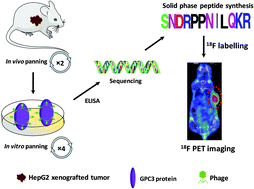The development of a Glypican-3-specific binding peptide using in vivo and in vitro two-step phage display screening for the PET imaging of hepatocellular carcinoma†
Abstract
Glypican-3 (GPC3) is a diagnostic biomarker for hepatocellular carcinoma (HCC). Although numerous designs targeting GPC3 have been reported, the HCC diagnostic agents with specific tumor accumulation and low background, particularly in normal liver tissue, are still in need. Peptides have attracted considerable attention as an imaging probe due to their low immunogenicity, short in vivo circulation time, and acceptable production cost. Herein, a two-step phage display screening approach was performed against GPC3-high expression tumor xenografts in vivo, followed by human recombinant GPC3 protein in vitro. A GPC3-specific binding peptide, named TJ12P2, with the sequence of Ser-Asn-Asp-Arg-Pro-Pro-Asn-Ile-Leu-Gln-Lys-Arg (SNDRPPNILQKR) was identified. The apparent Kd value between TJ12P2 and the GPC3 protein was measured as 158.2 ± 26.25 nM. After 18F labeling, 18F-AlF-NOTA-TJ12P2 was found accumulated in the tumors by positron emission tomography (PET) imaging in two HCC subcutaneous tumor models (HepG2 and SMMC-7721) with high GPC3 expression. Static PET imaging revealed that 18F-AlF-NOTA-TJ12P2 accumulation in the HepG2 and SMMC-7721 tumors reached 1.825 ± 0.296 %ID g−1 and 1.575 ± 0.520 %ID g−1, with tumor-to-muscle ratios of 4.14 ± 0.50 and 4.25 ± 0.25, respectively, at 30 min post-injection (p.i.). Much less accumulation (0.533 ± 0.078 %ID g−1) of the 18F-AlF-NOTA-TJ12P2 was found in the control PC3 tumors with low GPC3 expression. More importantly, no obvious normal liver uptake of TJ12P2 was observed in the abovementioned animal models. As a result, a novel peptide targeting GPC3, TJ12P2, with strong affinity and specificity was identified using a two-step phage display screening technique in the present study. The 18F-AlF-NOTA-TJ12P2 may be a promising PET imaging probe with translational potential for accurate HCC diagnosis.



 Please wait while we load your content...
Please wait while we load your content...